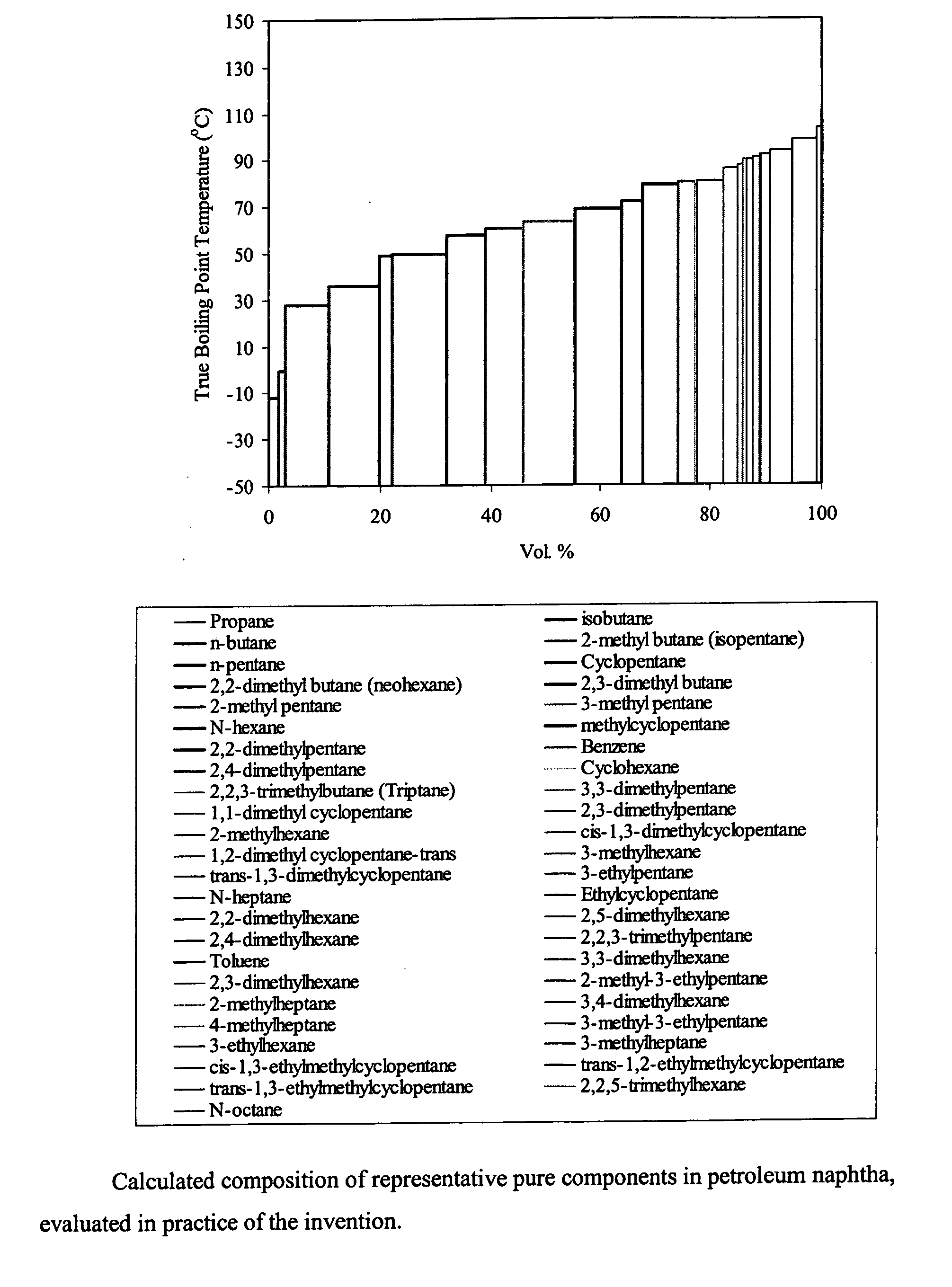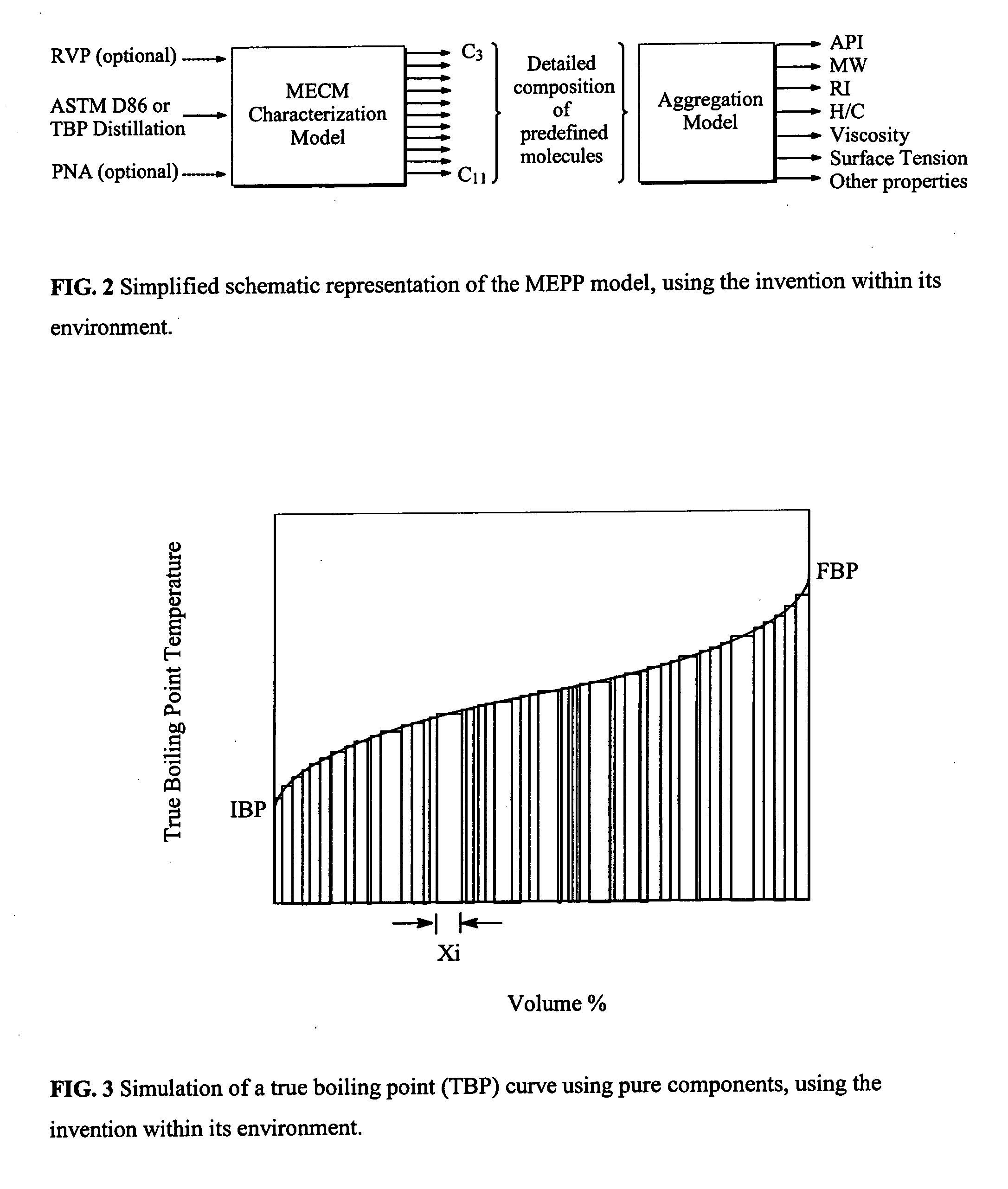Method and apparatus for measuring the properties of petroleum fuels by distillation
a technology of petroleum fuels and properties, applied in chemical methods analysis, instruments, material thermal analysis, etc., can solve the problems of affecting the motivation of analyzing each feedstock, affecting the efficiency of analyzing feedstocks, and analytical methods that do not find wide acceptance in daily refinery operations, so as to improve accuracy and reliability, fuel properties can be easily determined and displayed, and the effect of improving the speed of fingerprinting analysis
- Summary
- Abstract
- Description
- Claims
- Application Information
AI Technical Summary
Benefits of technology
Problems solved by technology
Method used
Image
Examples
example 1
A Molecularly-Explicit Characterization and Property Prediction Method
[0111] In one embodiment, the property prediction model is based on the concept that the global properties of a petroleum fraction such as the TBP distribution, vapor pressure, PNA fractional composition must be equal to those calculated from the pure components comprising that petroleum fraction. When some bulk and pure component properties are available, the composition of a limited set of pure components in the petroleum fraction may be predicted using optimization algorithms as simplified in FIG. 2. The predicted composition may then be used to predict the other global properties of the petroleum fuel using appropriate mixing rules.
[0112] The standard input global-properties for the model are the petroleum fractions distillation data (either ASTM D86, TBP, SimDist, etc), the RVP, and the PNA content. The internally calculated global properties are the molecular weight, the true vapor pressure at 37.8° C., th...
example 2
Property Prediction of Petroleum Fractions Using the Pseudocomponent Method
[0191] According to the method of the present invention, the boiling point distribution, such as that obtained from the ASTM D86 distillation for example, is first fitted to any form of algebraic equation such as the probability density function, PDF, (Equation 24) or a fourth order polynomial function (Equation 23), and the like with the latter being more preferred. This is used to generate a multitude of boiling point values (Tbi) at desired values of the samples volume % distilled.
[0192] The property of the petroleum fraction is calculated using the following equation,
Property=Σ(xv)i(PVBI)i where i=1, 2, 3, . . . , n (51)
where (xv)i is the volume fraction of the pseudocomponent cut, n is the number of pseudocomponent cuts, and (PVBI)i is the property volume blending index of cut i given by the following quadratic equation,
(PVBI)i=a+b(Tb)i+c(Tb)i2 (52)
[0193] The property volume blending index cou...
example 3
Property Prediction of Petroleum Fractions Using Neural Networks
[0209] An artificial intelligence system can be used with a conglomeration of boiling point distribution data to provide a method of improving recognition of an unknown from its boiling pattern. Customized neural network systems allow the ultimate organization and resourceful use of variables already existing in the distillation apparatus for a much more comprehensive, discrete and accurate differentiation and matching of boiling point than is possible with human memory. The invention provides increased speed of fingerprinting analysis, accuracy and reliability together with a decreased learning curve and heightened objectivity for the analysis.
[0210] Characteristic boiling point distributions are obtained for the materials via distillation techniques including ASTM D86, ASTM D1160, and the like. Desired portions of the boiling point distribution may be selected and then placed in proper form and format for presentati...
PUM
 Login to View More
Login to View More Abstract
Description
Claims
Application Information
 Login to View More
Login to View More - R&D
- Intellectual Property
- Life Sciences
- Materials
- Tech Scout
- Unparalleled Data Quality
- Higher Quality Content
- 60% Fewer Hallucinations
Browse by: Latest US Patents, China's latest patents, Technical Efficacy Thesaurus, Application Domain, Technology Topic, Popular Technical Reports.
© 2025 PatSnap. All rights reserved.Legal|Privacy policy|Modern Slavery Act Transparency Statement|Sitemap|About US| Contact US: help@patsnap.com



